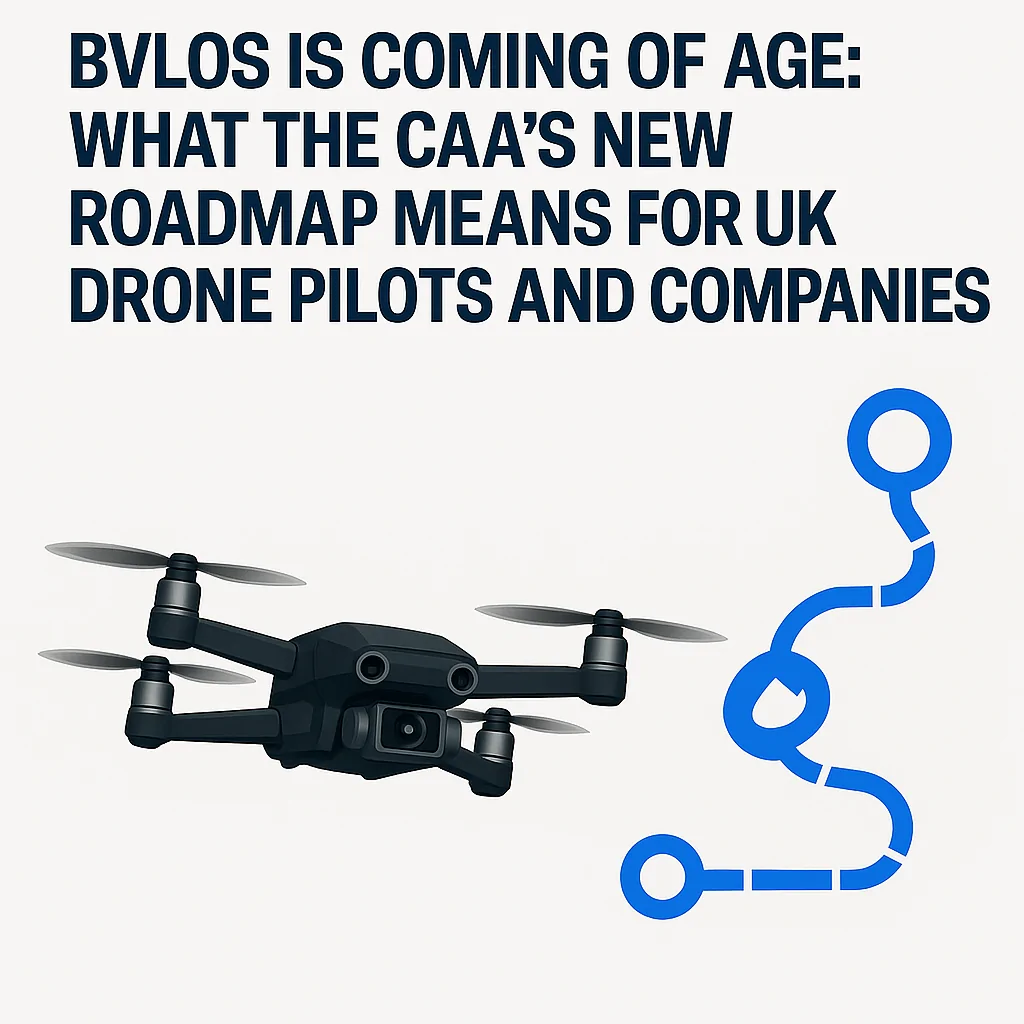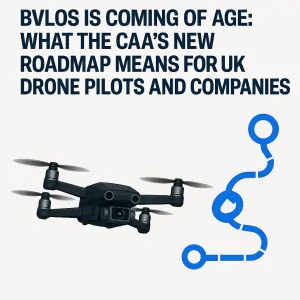BVLOS is coming of age: what the CAA’s new roadmap means for UK drone pilots and companies
30th October 2025


By Richard Ryan barrister and drone lawyer – practical takeaways, not legal advice.
The short version
The Civil Aviation Authority’s CAP3182 – Future of Flight: BVLOS Roadmap sets a clear direction:
routine BVLOS operations by 2027 across priority use cases (NHS, emergency services, infrastructure, commercial delivery) and
initial commercial AAM passenger flights by the end of 2028. The CAA intends to get there iteratively, using live operations to harden policy across three BVLOS operational pathways:
Atypical Air Environment (AAE), Low-Level over Urban Areas, and Fully Integrated BVLOS.
Expect a steady shift from temporary segregation to true integration with Electronic Conspicuity (EC), Detect-and-Avoid (DAA), and UTM-ATM interaction.
Why this matters
Two features distinguish this roadmap. First, it is outcome-focused, linking policy development to concrete operations (for example, linear infrastructure inspection and hospital-to-hospital logistics).
Secondly, it is explicitly sequenced: segregation is a stepping stone to integration. Policies will develop iteratively, with the CAA learning from live operations rather than waiting for a single “big-bang” rule change.
The roadmap is also tied to the UK’s Airspace Modernisation Strategy, with proposals due in 2026 that matter if you are planning national networks.
The three BVLOS pathways (and typical use cases)
- Atypical Air Environment (AAE) – BVLOS close to fixed ground infrastructure. Examples: linear inspection of power lines, railways, wind turbines; security and surveillance; agriculture.
- Low-Level over Urban Areas (below 500 ft AGL) – Integrated operations over populated areas. Examples: last-mile deliveries (NHS samples, consumer goods); urban inspection.
- Fully Integrated BVLOS (all classes of airspace) – Integrated operations without special airspace. Examples: emergency air services; offshore asset inspection; middle-mile logistics.
Note: Two other BVLOS pathways sit in the wider portfolio: Non-military State aircraft and Test and Evaluation (enabled today in segregated airspace).
What becomes “routine” when? (Roadmap at a glance)
Atypical (AAE)
- Now (A0): Single-operator missions (for example, railway inspection, perimeter patrols).
- By ~2027 (A1): Multiple operators in the same AAE segment (for example, consecutive missions along the same railway).
Heads-up: The definition and extent of AAE may be reviewed and expanded over time, unlocking more locations and volumes.
Low-Level over Urban
- LL0 (now): Single operator, bespoke entry conditions, often within a TRA/TMZ.
- LL1: Multiple operators in controlled airspace without temporary structures.
- LL2: Multiple operators in uncontrolled airspace – the most scalable for last-mile services.
Fully Integrated
- FI0: Segregated operations (for example, offshore monitoring in a temporary danger area).
- FI1: Specific volumes with bespoke entry conditions (for example, maritime TRAs/TMZs).
- FI2: Operations in controlled airspace without temporary structures.
- FI3: Operations across controlled and uncontrolled airspace – enabling nationwide networks.
Tech and policy enablers
Electronic Conspicuity (EC) and surveillance
- UAS equipage: ADS-B In/Out (978 MHz and/or 1090 MHz), progressively moving from trials to approvals with AMC/GM support at higher integration levels.
- Crewed equipage: Aligns with airspace requirements, with potential EC-mandate policy developments to watch.
- Ground infrastructure: Situational awareness feeds (for example, TIS-B) and information displays become more important for urban and fully integrated stages.
Detect-and-Avoid (DAA)
DAA starts as testing only within segregated airspace and progresses to approvals at higher assurance levels as reliance moves from bespoke procedures to technology-based mitigations (DAA and UTM).
UTM and ATM integration
- Early stages: UTM for flight planning and strategic UAS-to-UAS deconfliction.
- Maturing stages: Tactical deconfliction and procedures for UTM-ATM interaction, culminating in CISP-enabled information exchange.
C2 link robustness and SAIL
Command-and-control performance is tied to SAIL levels: SAIL 1-3 is acceptable early on, with SAIL 4+ moving from testing to approval as operations integrate further.
Air risk and ATC procedures
Residual Air Risk Class (ARC) rises as integration increases (from ARC-a towards ARC-c), and ATC interaction shifts from bespoke arrangements to standardised procedures.
Pathway-specific notes you can use in planning
Atypical Air Environment (AAE)
The AAE Policy Concept enables single-operator BVLOS near defined infrastructure, with guidance on operating at multiple sites and evidencing that missions qualify as AAE.
Expect UTM-based strategic deconfliction to unlock multi-operator AAEs (A0 -> A1).
So what? If you inspect rail, power, or wind, AAE is the lowest-friction BVLOS route today. Invest in ADS-B In/Out and UTM-connected operations to be ready for A1.
Low-Level over Urban
Partially integrated urban BVLOS has been demonstrated using TRA/TMZ access and bespoke procedures to mitigate mid-air collision risk while technology matures.
Over time, reliance shifts from temporary airspace to technology (DAA, UTM, EC), first in controlled and then uncontrolled airspace.
So what? For last-mile delivery pilots and NHS suppliers, plan for standardised ATC procedures, DAA approvals to higher assurance, ADS-B equipage, and access to ground infrastructure (for example, TIS-B) as operations scale from corridors to multi-operator networks.
Fully Integrated BVLOS (all airspace)
This pathway starts with segregated offshore work and progresses to routine operations in controlled and uncontrolled airspace without TRAs/TMZs.
The same EC/DAA/UTM/C2 themes apply, but at higher performance and assurance levels.
So what? If you are building middle-mile logistics or national inspection services, design now for scalable EC, tactical deconfliction, resilient C2 (SAIL 4+), and a concept of operations that works without special airspace.
Regulatory framing (how it fits with what you know today)
- Category and authorisations: BVLOS sits in the Specific or Certified category, typically via a SORA-based safety case with mitigations aligned to SAIL. CAP3182 signals the mitigations expected at each stage (EC, DAA, C2, UTM).
- Policy development: The CAA plans to publish interim Concepts of Operation and use live-ops data to refine policy – so early movers who share data help shape the scalable rules.
- Airspace modernisation: All of this is tied to the AMS; the 2026 airspace architecture proposals will underpin integrated UAS operations.
Practical actions for pilots and operators (2025-2027)
- Map your operation to a pathway and scenario. Decide whether you are AAE (A0 -> A1), Urban (LL0 -> LL2), or Fully Integrated (FI0 -> FI3); plan the evidence needed for the next step.
- Plan your EC roadmap. Budget for ADS-B In/Out (978/1090 MHz), integration, and participation in ground-based situational awareness where relevant.
- Design for DAA maturity. For urban and fully integrated pathways, assume DAA approvals to higher assurance; capture testing data now.
- Harden your C2 links. Align architecture to the SAIL you need (for example, moving from SAIL 1-3 to SAIL 4+).
- Adopt UTM early. Use UTM for planning and strategic deconfliction; prepare for tactical deconfliction and UTM-ATM data exchange via CISP/SWIM.
- Write to the signalled ConOps. Prefer standardised mitigations over bespoke procedures, and reflect this in your operations manual, training, and safety assurance.
- Mind the non-aviation risks. Data protection, cybersecurity for C2/UTM interfaces, community engagement (noise, privacy), and appropriate insurance matter more as you scale.
Risks, dependencies, and what to watch
- Funding, industry progress, legislation: Dates depend on these; the CAA plans to update the roadmap annually.
- AAE scope may expand: Over time the height/extent could increase, enabling more sites with efficient authorisation and deconfliction checks.
- Shift from bespoke to standard: Expect standardised ATC interfaces and technology-based mid-air collision mitigations across all pathways as policy matures.
Jargon buster (as used in the roadmap)
- AAE – Atypical Air Environment: defined volumes near specific infrastructure.
- TRA/TMZ – Temporary Reserved Area / Transponder Mandatory Zone: temporary segregation while technology is proven.
- DAA – Detect-and-Avoid: onboard/ground systems to mitigate mid-air collision risk.
- EC – Electronic Conspicuity: making aircraft electronically visible; references ADS-B In/Out.
- UTM/ATM – UAS Traffic Management / Air Traffic Management: digital services for planning, deconfliction, and ATC interaction.
- SWIM – System-Wide Information Management; CISP – Common Information Services Provider: information exchange between UTM and ATM.
- SORA/SAIL – Risk assessment method (SORA) and levels of safety assurance (SAIL) in the Specific category.
- ARC-a/-b/-c – Residual Air Risk Class: increasing exposure as operations integrate into busier airspace.
Final thought
CAP3182 does not just set ambition; it points to the levers operators should pull to progress BVLOS:
EC equipage, DAA maturity, UTM participation, resilient C2, and standard interfaces with ATC.
Align your safety case and investment roadmap now to benefit as the CAA reduces reliance on temporary segregation and opens up routine BVLOS at scale by 2027.
Source: UK Civil Aviation Authority, CAP3182 – Future of Flight: BVLOS Roadmap (October 2025).
Disclaimer: General information from a UK drone law perspective; not legal advice.
About the Author
Richard Ryan is a Barrister (Direct Access), Mediator and Chartered Arbitrator based in the UK, specialising in drone and counter-drone law, aviation regulation, and complex commercial disputes. He advises operators, insurers and public bodies on SORA/AAE approvals, BVLOS programmes, privacy/data governance, and risk allocation across the drone ecosystem

